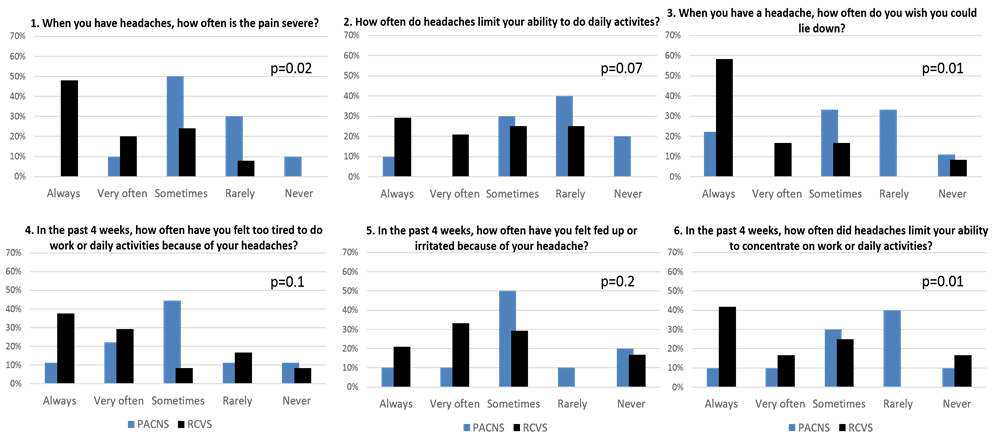Session Information
Session Type: ACR Poster Session C
Session Time: 9:00AM-11:00AM
Background/Purpose: Primary angiitis of central nervous system (PACNS) is an isolated vasculitis affecting small-sized cerebral blood vessels. One of the major mimickers of PACNS is reversible cerebral vasoconstriction syndrome (RCVS). Both entities have distinctive pathophysiology, prognosis and therapeutic implications and differentiation between both is prudent. In this study, we aimed to compare the clinical and imaging characteristics of PACNS and RCVS cases at the presentation to better differentiate these entities.
Methods: Patients from Cleveland Clinic prospective RCVS-PACNS registry were included in the study. PACNS cases were included if they had a biopsy consistent with vasculitis or positive angiography and inflammatory cerebrospinal fluid pattern. Patients were asked to fill out questionnaires regarding their symptoms at presentation, headache impact test (HIT-6) and migraine disability assesment test (MIDAS). Brain MRI and cerebral angiography performed near the time of presentation were blindly evaluated by one neuroradiologist and two interventional radiologists, respectively.
Results: Our study included 28 PACNS and 45 RCVS cases. Main results are summarized in table. Female patients were more commonly affected by RCVS compared to males (3.5:1). RCVS cases more commonly presented with headache than PACNS cases. Headache was often insidious and dull in PACNS, whereas it was sudden and thunderclap in RCVS. Time for headache to peak was reported as seconds and intensity of headache was higher in RCVS cases. Neurologic deficit was more commonly associated with headache in PACNS than RCVS cases.
Appearance of vascular abnormality on cerebral angiogram was sausage-like in most of the RCVS and irregular in most of the PACNS cases. Subarachnoid hemorrhage was more common on MRI of RCVS cases, while nonspecific white matter changes were more common in PACNS cases. Lesions were superficial (involving cortex and subcortical white matter) in RCVS and deep (deep and periventricular white matter) in PACNS cases. Total score of MIDAS was higher in RCVS indicating more disability due to headache in these cases (p=0.01). Results of HIT-6 are shown in the figure.
Conclusion: PACNS cases experience insidious-onset and dull headache, while RCVS cases often experience sudden, more severe and disabling headache. Radiologic signs such as nonspecific white matter changes, deep location of lesion, and irregular appearance of the vessel on angiogram are more commonly seen in PACNS cases, and can help guide clinicians in differential diagnosis.
|
|
PACNS (n=28) |
RCVS (n=45) |
P value |
|
Demographics |
|||
|
Age |
46.7±14.3 |
45.8±13.3 |
0.9 |
|
Gender (F:M) |
13:15 |
35:10 |
0.006 |
|
Race (White/Black/Other) |
27/0/1 |
38/6/1 |
0.1 |
|
Headache characteristics |
|||
|
Presence of headache |
18 (69.2%) |
36 (97.3%) |
0.001 |
|
Insidious/Thunderclap headache |
6/3 |
3/30 |
0.0002 |
|
Time for headache to peak (hours/minutes/seconds) |
3/2/1 |
1/4/21 |
0.002 |
|
Intensity of headache (0-100) |
51.1±22.6 |
75.4±25.1 |
0.01 |
|
Dull headache |
3 (30%) |
1 (2.94%) |
0.03 |
|
Neurologic deficit associated with headache |
15 (83.33%) |
19 (52.77%) |
0.03 |
|
Exposure to vasoactive substance |
3 (18.75%) |
15 (53.12%) |
0.03 |
|
Imaging characteristics |
|||
|
Appearance of irregularity on cerebral angiogram (sausaging/irregular, notched) |
4/7 |
27/1 |
<.0001 |
|
Subarachnoid hemorrhage on MRI |
1 (4.76%) |
14 (41.17%) |
0.004 |
|
Non-specific white matter changes on MRI |
7 (33.33%) |
3 (8.82%) |
0.03 |
|
Superficial location of lesion on MRI |
5 (15.15%) |
14 (45.16%) |
0.01 |
|
Deep location of lesion on MRI |
12 (36.36%) |
5 (16.12%) |
0.02 |
To cite this abstract in AMA style:
Saygin D, Cerejo R, Sundaram-Simonelli P, Toth G, Jones S, Calabrese LH, Hajj-Ali RA. Differentiating Features of Primary Angiitis of Central Nervous System and Reversible Cerebral Vasoconstriction Syndrome: Clinical and Radiological Evaluation [abstract]. Arthritis Rheumatol. 2017; 69 (suppl 10). https://acrabstracts.org/abstract/differentiating-features-of-primary-angiitis-of-central-nervous-system-and-reversible-cerebral-vasoconstriction-syndrome-clinical-and-radiological-evaluation/. Accessed .« Back to 2017 ACR/ARHP Annual Meeting
ACR Meeting Abstracts - https://acrabstracts.org/abstract/differentiating-features-of-primary-angiitis-of-central-nervous-system-and-reversible-cerebral-vasoconstriction-syndrome-clinical-and-radiological-evaluation/

